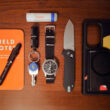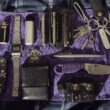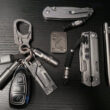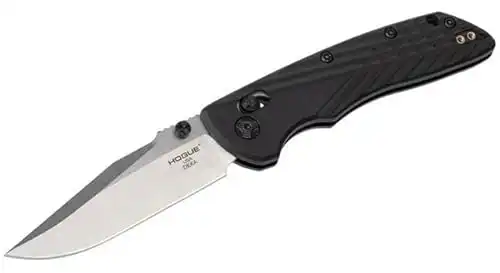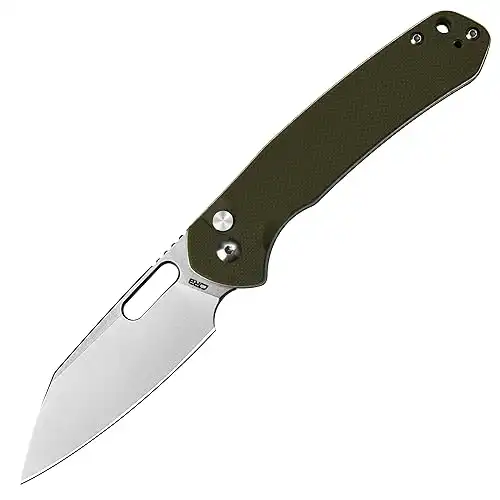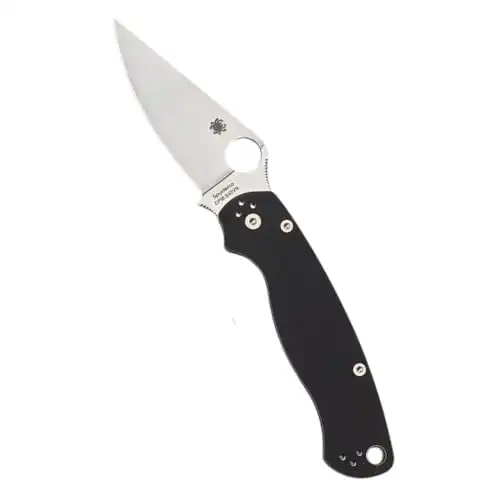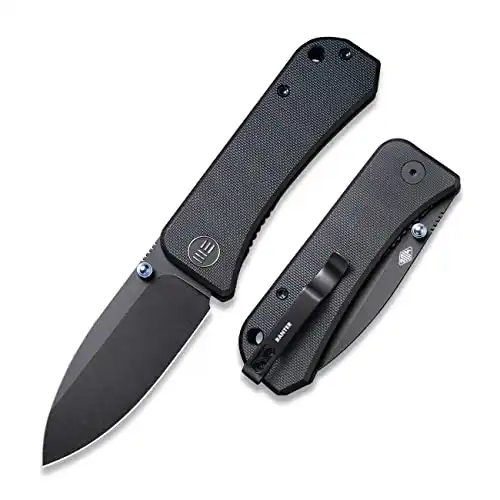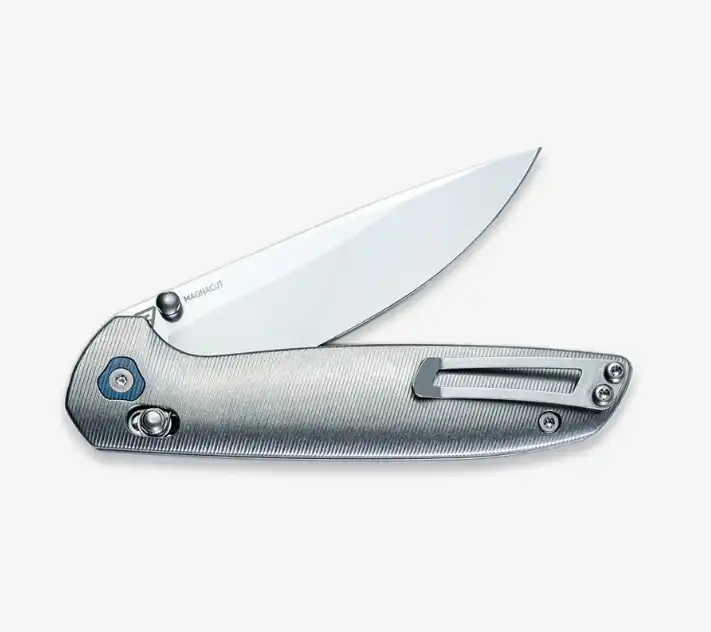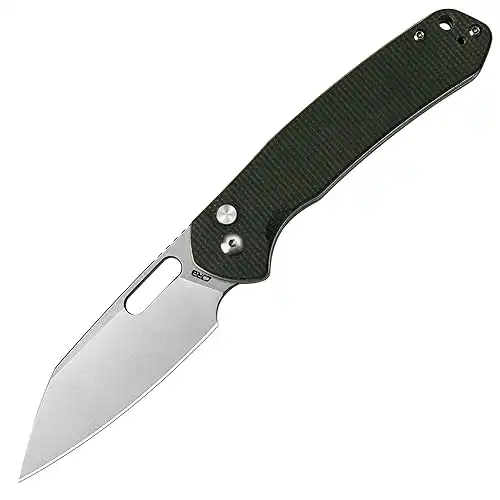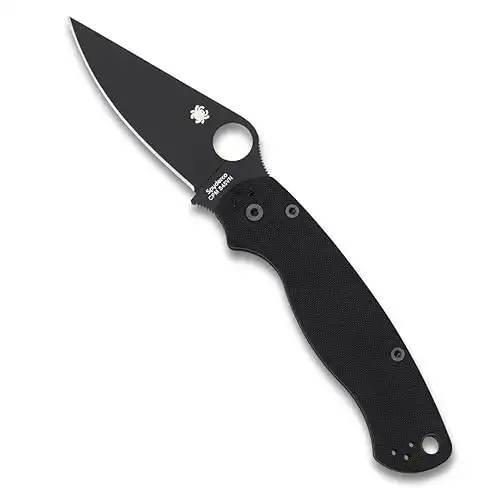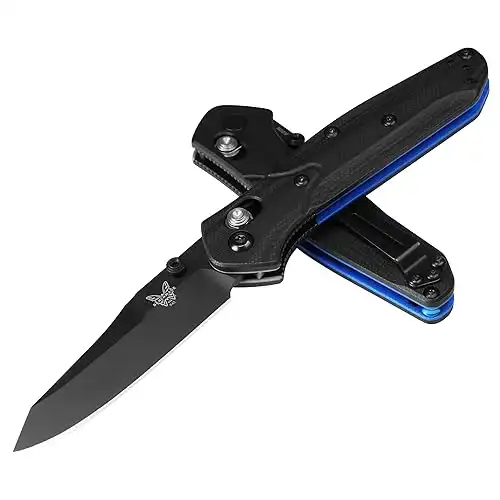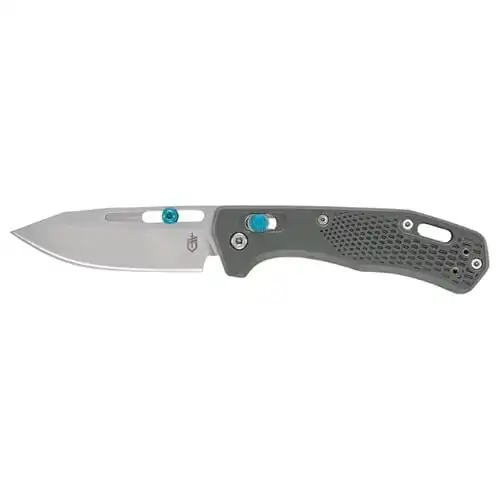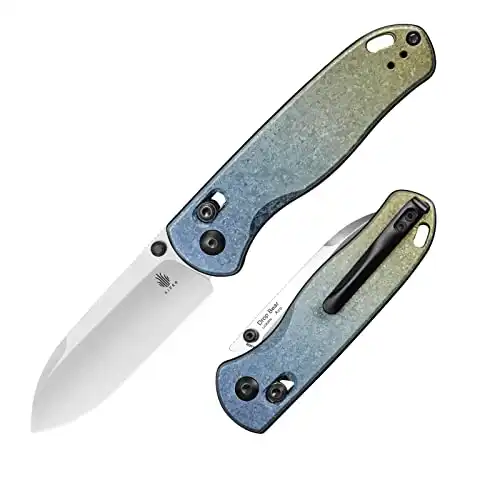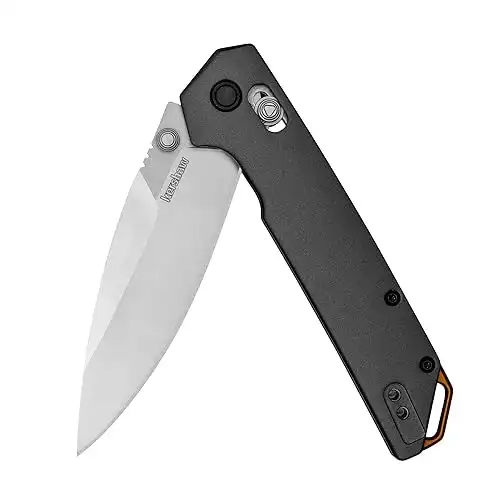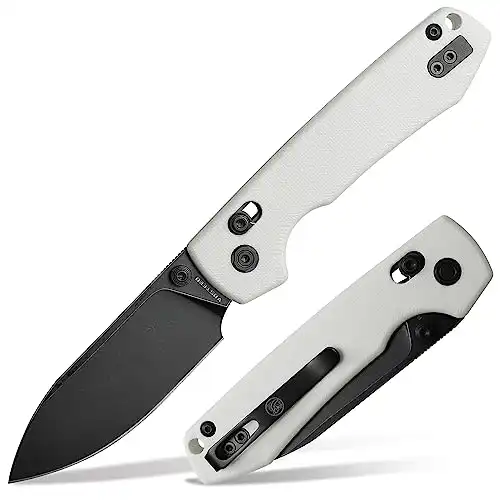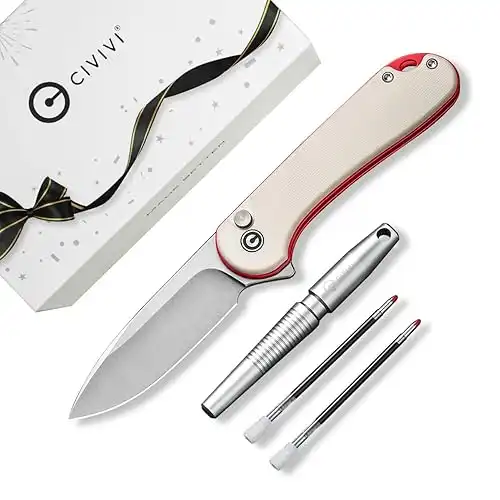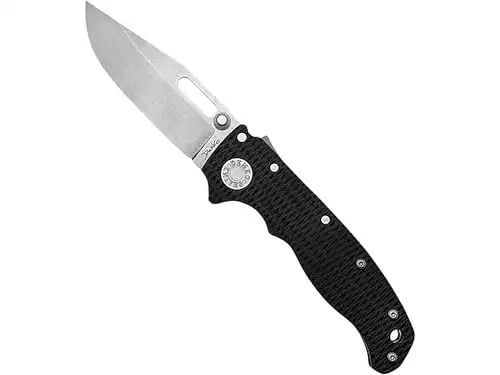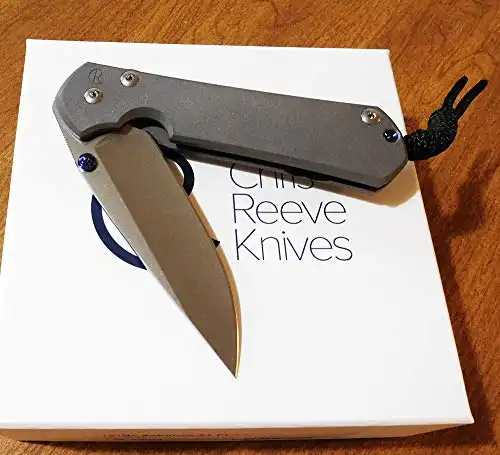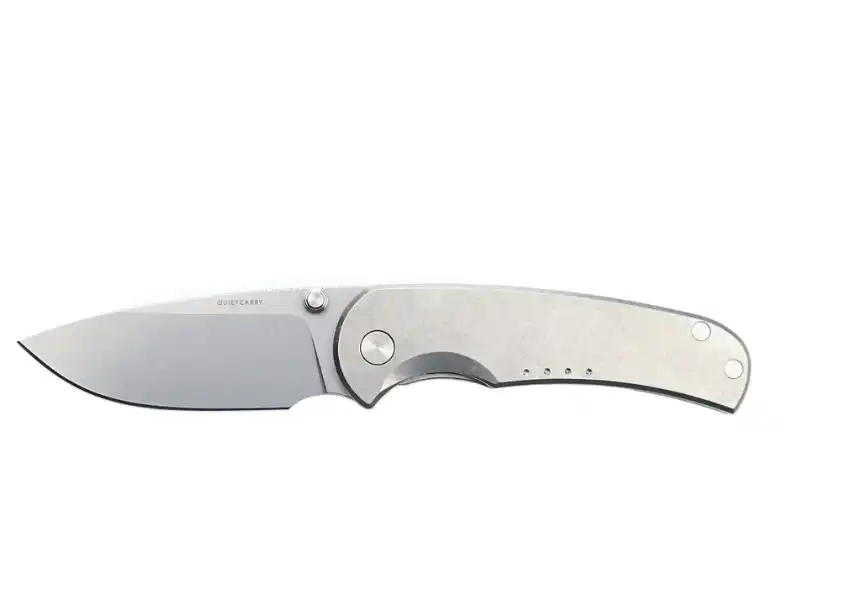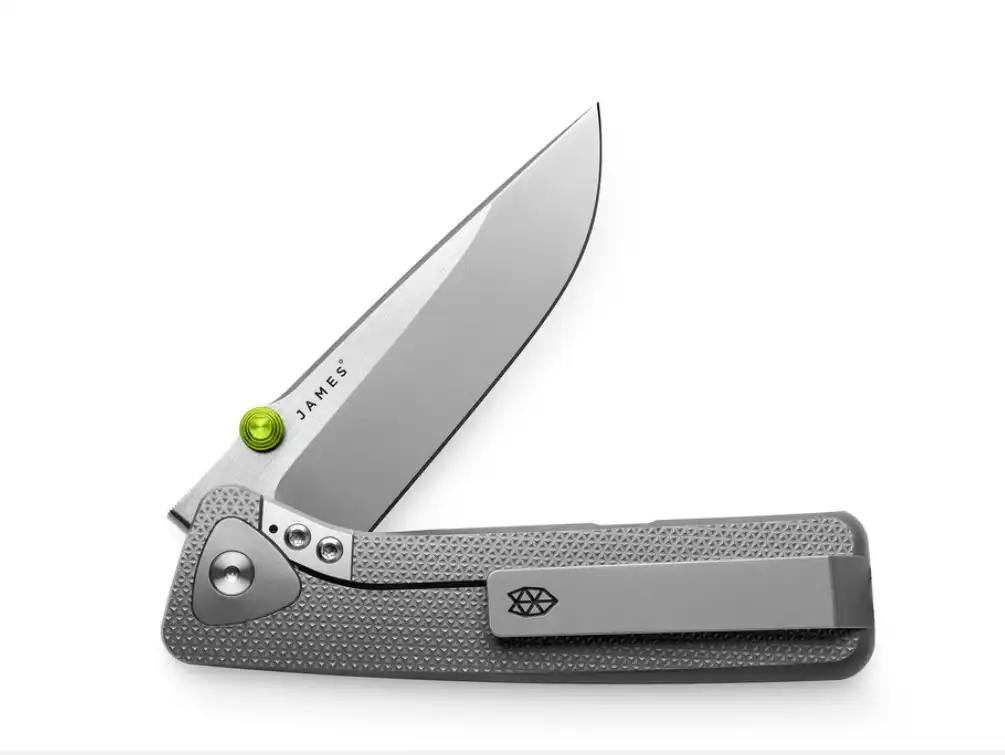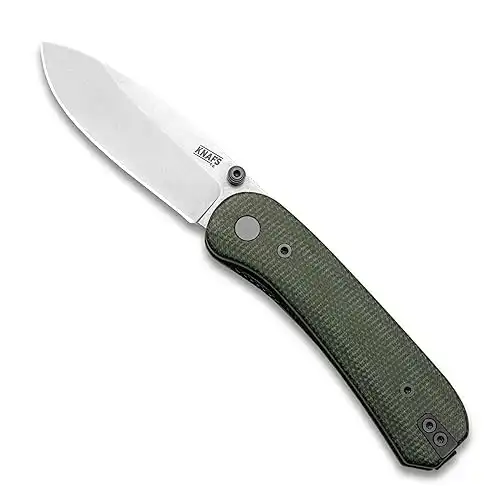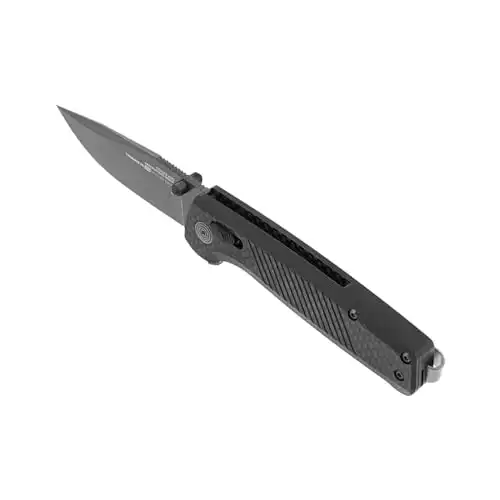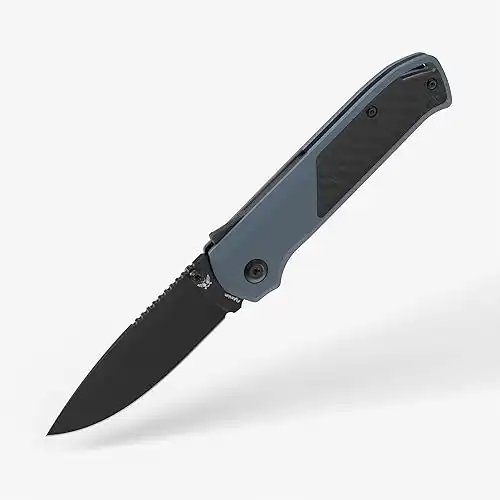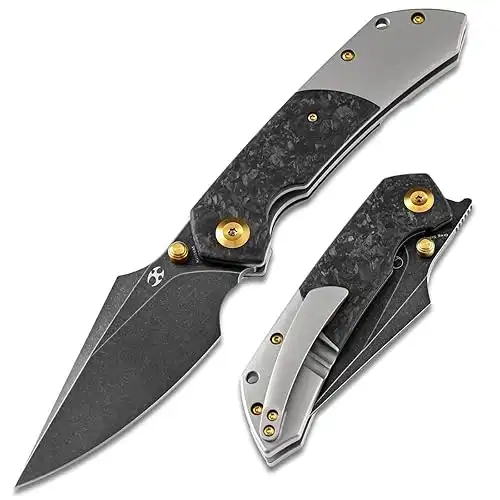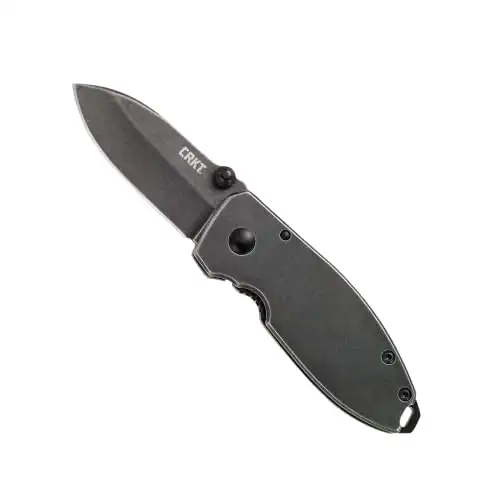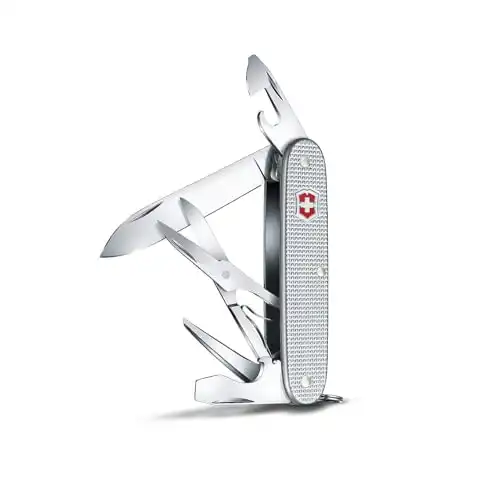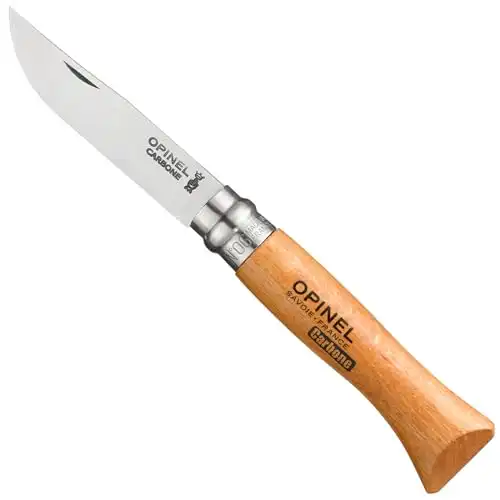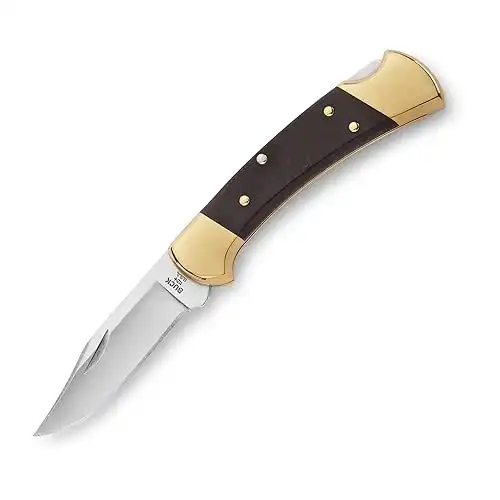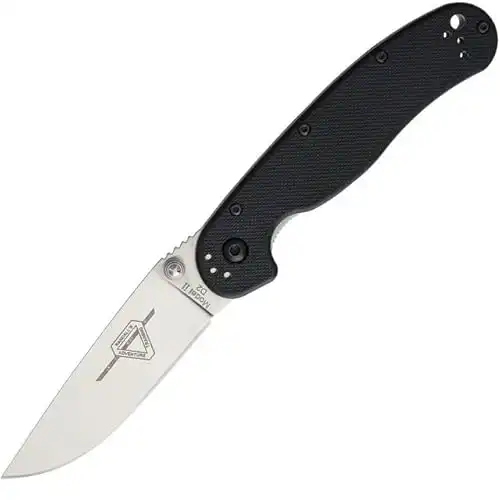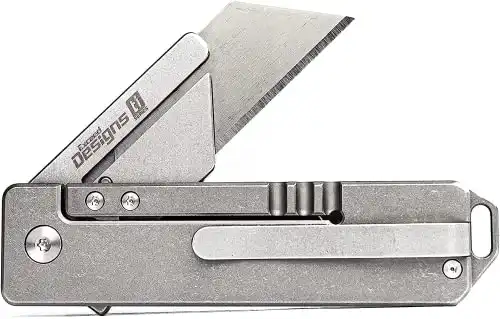A pocket knife is one of the most essential parts of my everyday carry, and judging by how often it features in the community, it’s a popular part of everyday carry, period. While it’s an essential staple in many people’s pockets, the sheer number of options on the market may make it difficult to select the best one for your setup. And that’s even before considering restrictions like certain industries where some knives may be less effective at getting the job done or restricted by rule or law.
But I’m here to help you choose the best pocket knife for your everyday carry. A good pocket knife comes in handy in many ways, from everyday tasks like opening packages, preparing food at home or outdoors, or all manner of emergencies. In this extra-comprehensive buying guide, I’ll explain what to look for when choosing the best pocket knife for your everyday carry and highlight my 25 favorite options to make your search for your next pocket knife easy.
This post was last updated on 07/28/2025.
The Best Pocket Knives of 2025

The Best Overall Pocket Knife 🏆: Hogue Deka [Buy]
The Best Pocket Knife on a Budget: CJRB Pyrite Alt [Buy]
The Best Tactical Pocket Knife: Spyderco Para Military 2 [Buy]
The Best Everyday Pocket Knife: WE Knife Co. Banter [Buy]
The Best Premium Pocket Knife You Can Actually Buy: Tactile Maverick [Buy]
|
The Best Overall Pocket Knife 🏆
|
The Best Pocket Knife on a Budget
|
The Best Tactical Pocket Knife
|
The Best Everyday Pocket Knife
|
The Best Premium Pocket Knife
|
|
$114.30
|
$43.32
|
$207.00
|
$110.75
|
$349.00
|
|
Pros:
|
Pros:
|
Pros:
|
Pros:
|
Pros:
|
|
Cons:
|
Cons:
|
Cons:
|
Cons:
|
Cons:
|
|
Bottom Line:
If you asked me what’s the best pocket knife for everyday carry without giving me any other information, then the Hogue Deka would still be my pick for the best overall.
|
Bottom Line:
With its excellent action, powder steel blade performance, durable build, and impressive fit and finish, the CJRB Pyrite Alt is a great way to get the modern EDC knife experience without breaking the bank.
|
Bottom Line:
With its larger proportions, excellent performance, and proven design, the Spyderco Para Military 2 sits as one of, if not the best, pocket knives for tactical and daily carry.
|
Bottom Line:
The Banter has quite a lot to offer to any knife enthusiasts, starting with a dead simple blade made of S35VN stainless steel that’s good for all-around cutting, slicing, and piercing tasks without needing too much to keep it in tip-top shape, sharp and good to go.
|
Bottom Line:
The fit and finish are everything you want from a premium everyday carry knife, and Tactile has taken everything they have learned through years of precision machining great everyday carry pens and stationery into this field, too.
|
|
Specifications:
|
Specifications:
|
Specifications:
|
Specifications:
|
Specifications:
|
- Great entry point to MagnaCut steel
- Plenty of alternate variations
- Ambidextrous crossbar lock and swappable clip
- Polymer handle may have more “give” than is preferred by some users
- Popularity may make it a bit harder to find now in its MagnaCut configuration
- Blade Length: 3.25”
- Blade Steel: CPM MagnaCut
- Handle Materials: Polymer
- Tons of variants both premium and budget
- More minimal thumbhole deployment
- Button lock is slightly less ambidextrous
- A bit heavy at 3.6 oz (with Micarta scales)
- Blade Length: 3.11"
- Blade Steel: AR-RPM9
- Handle Materials: G-10/Micarta
- Iconic Spyderco tactical knife
- Big blade performance
- Endless variations of steel, handles, and colors to choose from
- Size may be too prohibitive for those looking for a more discreet everyday knife
- Compression Lock isn’t truly ambidextrous but close enough
- Blade Length: 3.42"
- Blade Steel: CPM S45VN
- Handle Materials: G-10
- Friendly design
- Comes in two other size variations to best fit use cases
- Also plenty of variations
- Deployment can be a bit challenging
- Righty-only liner lock
- Blade Length: 2.9"
- Blade Steel: CPM S35VN
- Handle Materials: G-10
- Ultra-premium machining from the best in the business
- Made in the USA
- Comes in a more affordable variant
- Not limited edition, so always available to purchase
- Ambidextrous thumbstuds and crossbar lock, but righty-only clip position
- Omega spring may concern some potential buyers, especially at this price point
- Blade Length: 3.5"
- Blade Steel: CPM MagnaCut
- Handle Materials: Grade 5 Ti/Black Micarta

The Best Overall Pocket Knife: Hogue Deka
The best overall pocket knife for most people is the Hogue Deka. Ounce for ounce and dollar for dollar, it simply delivers the most value thanks to its top-tier blade steel, conveniently ambidextrous operability, and versatile design that can handle most applications from tactical to outdoor to everyday.
The Deka’s design is similar to one of the most popular everyday carry pocket knives, the Benchmade Bugout 535. It’s similar in size and shape, it’s also lightweight, also uses an ambidextrous dual thumbstud deployment and crossbar lock, and it’s also made in the USA. But it dethrones the Bugout 535 in two important ways: it features one of the most performant and sought-after blade steels on the market—CPM MagnaCut—while also costing a few dollars less.
The blade on the Deka performs just as well as I could hope for. The 3.25” blade is just the right size and shape for most tasks, and the CPM MagnaCut steel holds an edge, can take a beating, and fares well against exposure to water. I enjoy not really having to think about chipping the blade, dulling it too quickly, or taking precautions against rust so much, so I can really use the knife and knock it around a bit.
Read more:
The Drop: Hogue Deka MagnaCut Knife
The Drop: Hogue Deka MagnaCut Ultem Knife
It deploys easily, whether I flick it with my thumb or reverse flick with my index finger on the back of the blade. Hogue’s version of the crossbar lock worked flawlessly out of the box for me, and has since held up from regular use over a weeks-long testing period. While this style of lock is theoretically quite strong, notably ambidextrous, and even affords another way of opening the knife, you should be aware of the potential of the spring inside the lock failing. It’s a lower percentage, and I haven’t had any issues with mine, but users occasionally report failures.
One downside of the Hogue Deka is the same thing I experienced with the Benchmade 535 in my several years of owning and carrying them: the handles. While the polymer handles afford a barely-there, lightweight feeling in the pocket and nimbleness in hand, I can feel them flex under pressure. It doesn’t inspire the most confidence when it comes to hard use. Frustratingly, the Hogue Deka configuration that uses a heavier and sturdier handle material in G-10 does not come with the sought-after CPM MagnaCut blade steel, instead opting for a decent but not as good 20CV steel.
I think anyone who picks up the Hogue Deka except for very particular knife enthusiasts will be satisfied and impressed by the knife’s design and performance. If you don’t use a knife that often to warrant a supersteel or you need practically bombproof handles for extremely hard use, we’d recommend something else on this list instead. If you asked me “what’s the best pocket knife for everyday carry?” without giving me any other information, then the Hogue Deka would still be my pick for the best overall.

The Best Pocket Knife on a Budget: CJRB Pyrite Alt
We are spoiled for choice when it comes to good quality budget knives these days. I’ve tried a bunch of them (and will still mention several further on in this list), but my favorite of the bunch is the CJRB Pyrite Alt. Despite its low cost at under $50, it has the fit, finish, functionality, and fidget factor of a much more expensive knife. I enjoy the knife so much that I ended up getting three versions of it. That’s the beauty of budget blades–they don’t cost much, and you can really use them and beat them up without much worry.
The CJRB Pyrite comes in several variations, so I want to be specific with this recommendation. I think most budget-conscious buyers would like this “Alt” configuration of the Pyrite with a button lock and reverse tanto or wharncliffe blade shape. This version foregoes the dual thumbstuds for a thumbhole cutout in the blade. It makes the blade easier to deploy and fidget with, which is what I enjoy the most about this knife. Its ceramic bearings make the action on the knife snappy, smooth, and satisfying.
Cutting and slicing are no problems for the knife thanks to its 3.1” blade made from AR-RPM9. It’s Artisan Cutlery’s proprietary budget steel. But unlike other steels at this price, AR-RPM9 is a powder metallurgy steel, which is a type of steel usually reserved for more premium knives. I also like AR-RPM9 over a comparable budget steel like D2 simply because it’s a stainless steel and more corrosion resistant, which is important for when I use my knife in wet conditions.
Read more:
The Drop: CJRB Pyrite Knife
The Drop: CJRB Pyrite Blade HQ Exclusive Knife
The button lock also works great on every copy I own. I’ve tried other button locks from other brands that stick unless they’re pressed a certain way or have been broken in a ton, but the CJRB Pyrite Alt is consistently snappy. I also prefer button locks over frame or liner locks these days because they remove your thumb from the travel path of the blade upon closing, so there’s less risk of accidental cuts.
With its excellent action, powder steel blade performance, durable build, and impressive fit and finish, the CJRB Pyrite Alt is a great way to get the modern EDC knife experience without breaking the bank.

The Best Tactical Pocket Knife: Spyderco Para Military 2
Within the everyday carry and knife enthusiast communities, the Spyderco Para Military 2 (PM2) is so highly regarded it’s almost a meme at this point. It’s a decades-old design from Sal Glesser of Spyderco, but that design has stood the test of time thanks to its excellent ergonomics and overall practicality. It simply gets the job done–and in tactical situations, you’d accept no substitute.
There’s no denying the PM2 is a large knife. In my initial testing I thought I would struggle with the larger size (if you have small hands like me, consider the Spyderco Para 3). But in actual use, the knife is much more nimble and maneuverable than its dimensions might suggest–it’s far from cumbersome or bulky. I attribute most of this to how most of the bulk is in the handle, which gives you plenty of grip. Combined with the jimped finger choil and spine and light weight of the handle itself, you can choke up on the knife, and it feels like you’re just manipulating the blade only.
The blade shape affords a more usable cutting edge, with a slight upsweep to a precise point – making it excellent for all but heavy piercing tasks or prying. I can comfortably use it for food prep and opening packaging alike. The PM2 comes in a variety of excellent steels depending on the model. CPM S45VN is the standard: a premium, high-performance steel in its own right, but you can find variants with higher-spec steels like S90V (as shown) and even CPM MagnaCut (a top-tier steel) on recent models.
Deploying a Spyderco blade is a unique experience in itself, thanks to its large thumb hole and signature Compression Lock. It’s worth noting I can still operate the knife when using gloves, which might be an important consideration if you’re relegating this to a tactical setup. The iconic “Round Hole” lets you flick the blade open with your thumb like you’d expect or from the reverse side using your index or middle finger. Because the handle is a bit large, flicking the blade open is admittedly not super consistent for me. Instead, I prefer “dropping” the knife open by pinching the thumbhole and using the large handle’s weight and momentum to open the handle rather than the blade.
Once deployed, the Spyderco Para Military 2 locks via Compression Lock. To put it simply, it’s similar to a liner lock, but on the spine of the knife. This makes the lock very strong and safer to use, as disengaging the lock puts your fingers away from the blade’s path like a backlock might. However, one downside is that it is less intuitive for left-handed users (pro tip: lefties can simply pinch the lock using their index finger instead of their thumb. There are also after-market modification parts that make the lock easier to depress).
With its larger proportions, excellent performance, and proven design, the Spyderco Para Military 2 sits as one of, if not the best, pocket knives for tactical and daily carry.

The Best Everyday Pocket Knife: WE Knife Co. Banter
Few knives are built with as much expertise about what makes for an excellent everyday carry knife as the Banter from WE Knife Co. The Banter was made in collaboration with Ben Petersen, formerly of Blade HQ, one of the community’s favorite places to buy knives for everyday carry. Essentially built as his dream knife, it has quite a lot to offer to any knife enthusiasts, starting with a dead simple blade made of S35VN stainless steel that’s good for all-around cutting, slicing, and piercing tasks without needing too much to keep it in tip-top shape, sharp and good to go.
Another positive aspect of the WE Banter is its non-threatening appearance and smaller size, making it a knife that won’t turn too many unwanted eyes when used in polite company. When the knife is fully closed, the blade sinks deep into your pockets, and the frame cuts a very discreet profile that doesn’t rub up against your body and the other stuff in your pockets simultaneously. I also like that the handle is made of G-10, making it as lightweight, grippy, and compact as possible while giving you a firm grasp during use.
Read more:
Trending: WE Knife Co. Banter
The Drop: WE Knife Co. Big Banter Knife
If I were to nitpick a little, the deployment and lockup hold this knife back. That’s because the dual thumb studs might be too small for some hands. They are also closer to the handle, so it can be hard to actuate, especially if you are trying to open the knife with your non-dominant hand. And on that note, liner locks do favor right-handed people. Newer everyday carry knives tend to favor more ambidextrous designs that make it easy to open, close, and use with either of your hands.

The Best Premium Pocket Knife You Can Actually Buy: Tactile Maverick
The Maverick is a premium modern crossbar lock pocket knife made in collaboration with Richard Rodgers, a two-time Blade Show award winner who has been making great everyday carry knives in New Mexico since 1996. Tactile takes American-forged CPM MagnaCut steel and fashions it into a 3.5” clip-point blade with a slight upswept shape, making the knife excel at detail cutting and slicing with a fine and pointy tip.
You can choose between a grade 5 titanium handle or a canvas micarta scale. Either way, the rest of the knife evokes a fine modern gents’ design with quality-of-life features like a deep carry pocket clip, a custom pivot tuned for smooth draw and closure, and titanium hardware that won’t rust over time and use. The fit and finish are everything you want from a premium everyday carry knife, and Tactile has taken everything they have learned through years of precision machining great everyday carry pens and stationery into this field, too.
Read more: Tactile Knife Co. Maverick
The result is a knife designed by one of America’s best custom knife crafters, made of American materials, and assembled in Texas by Tactile Turn. Even better, the Tactile Maverick is not a limited-edition knife, so if the looks and performance appeal to you, it’s available for purchase right now. No waitlists are required, and there’s no secondary market taking advantage of artificial hype building to navigate when picking up a Maverick for your everyday carry.
Our Other Recommendations

Benchmade 945 Mini Osborne
It’s no accident that most of the knives on the list will resemble this iconic knife design from Benchmade. The 945 Mini Osborne takes everything that makes the original 940 a classic, then reins in the proportions to something more efficient and streamlined for EDC.
Its blade measures just shy of 3”, making it legal to carry in more places. Boasting a premium CPM S30V steel, the blade is plenty capable for most end users. Because the knife is a few years old now, it doesn’t boast the latest and greatest specs. But Benchmade was the first to implement many of these features anyway, like the ambidextrous crossbar lock (the generic term for Benchmade’s once-patented AXIS lock) and dual thumbstud deployment.
Read more: Trending: Benchmade 945BK-1 Mini Osborne
You might see recommendations elsewhere for the Benchmade Bugout 535, the newer and arguably better icon from the Portland-based brand. But I recommend the 945 Mini Osborne over the 535 Bugout in spite of its higher price because it has sturdier feeling aluminum handles and a more distinct design language. The 535 is less competitive because of so many similar alternatives at lower price points, but the 945 still stands unmatched in the Benchmade lineup, in my opinion.
If you’re going to pick a semi-premium American-made knife from this storied brand today, then I recommend picking up the slightly older Benchmade 945 Mini Osborne while you still can.

Gerber Assert
The Gerber Assert also competes in the same category of semi-premium, American-made, lightweight, ambidextrous knives for outdoor and EDC duty. It also uses CPM S30V steel with a 2.99” blade length, housed between lightweight glass-filled nylon handles. The Assert has a unique combination of more subtle details and proportions that make it a worthy consideration amongst the competition. Its 3” blade and slightly chunkier shape make it a somewhat beefier middle-ground between Benchmade’s Bugout Mini (2.82”) and the full-sized Bugout (3.25”).
Read more: The Drop: Gerber Assert USA-Made Knife
I tested a customized Assert and found that its overall performance and carry experience was satisfactory for the price. I enjoyed the chunkier blade shape and the extended thumb hole with adjustable thumbstuds to dial in the deployment. My main complaint with the Assert was its pocket clip was less elegant than other knives I’ve handled, and the action was a bit stiffer and more deliberate than other similar knives. Go for the Assert if you want this style of American-made, drop point, premium steel knife with a crossbar lock and thumbstud deployment and you enjoy its slightly beefier, more rugged proportions and execution.

Kizer Azo Drop Bear
When it comes to everyday carry pocket knives, a common misconception I’ve seen is thinking that stainless steel means rustproof. The Kizer Azo Drop Bear is; however, one of those everyday carry knives that actually has a steel blade that’s pretty much impervious to rust. That’s because the knife features LC200N steel, which is highly corrosion-resistant. While you should still care for and maintain this knife, it’s a great choice for everyday carry in humid climates or working in wet (and salty) conditions.
The Kizer Azo Drop Bear’s overall design language resembles similar crossbar-style knives, except it has its own identity of being more overbuilt. Its thicker handles, stubby blade, and ample jimping translate to a much more robust and substantial feel in hand. The blade deploys and locks with ambidextrous action thanks to the crossbar lock and thumbstuds, but to me, it feels twangy in the way the lock is tensioned.
To summarize, consider the Kizer Azo Drop Bear if you’re looking for a more premium, robust-feeling knife that can stand its own in wet conditions and everyday use.

Kershaw Iridium
For decades now, Kershaw has offered solid production pocket knives in the budget EDC category (and they show their manufacturing prowess with their higher-end sister brand, Zero Tolerance). And while many of their popular knives, like the Leek, Cryo, or Link were good when they first debuted, they’re a bit outdated now. My experience with my Iridium has convinced me it’s a contender to be a new Kershaw classic as their take on the ambidextrous crossbar lock knife.
The Iridium sets itself apart from other crossbar lock knives in the sub-$100 range with its elongated, elegant proportions on the blade juxtaposed with more rugged materials like D2 tool steel and aluminum handles. It’s a perplexing combination that somehow works, and it ends up feeling like I’m getting a whole lot of knife for not a lot of money.
I find the Iridium to be an excellent slicer thanks to its thinner blade and pointier tip. The action is satisfying as well, with the longer blade still swiftly swinging out with a flick of the thumbstud or disengaging of the crossbar lock. I do need to caution that my first copy of the Iridium seemed to be a defective return that Amazon sold me as new, which had a wonky, clanging feel when tensioning the lock. The replacement worked flawlessly out of the box and impressed me during work shifts, breaking down boxes and other packaging.
Read more: Kershaw’s New DuraLock Knife Lineup for 2023
If I could improve the Iridium, I would upgrade its steel to something more stainless and have some machined texture in the handle for better grip. I had reservations about using this in the rain because of its D2 steel being rust-prone and the handle being slippery as is. Kershaw did address some of these issues with a limited edition premium version of the Iridium, featuring highly corrosion-resistant CPM 20CV blade steel and upgraded titanium handles. Unfortunately, it’s already discontinued.
But even in its base configuration, the Kershaw Iridium delivers an excellent EDC knife experience with its own unique design identity. If you’re okay with avoiding wet conditions or taking more care of the D2 blade, I recommend the Kershaw Iridium.

Vosteed Raccoon Crossbar
Vosteed has been making waves lately for its unique designs and enthusiast features at value-packed price points. The Vosteed Raccoon in the crossbar lock configuration is a prime example of this. It boasts a sizable 3.25” blade in a performant 14C28N steel, highly versatile drop point blade shape, complete with ambidextrous dual thumbstud crossbar deployment and lockup. It’s available in G-10 or Micarta handles, which offer excellent durability, grip, and water resistance without the flimsy, flexy feeling of plastic handles that the more ultralight knives on this list tend to use.
Like all the Vosteed knives I’ve used, the Raccoon has an above-average fidget factor and consistently satisfying action. The blade steel and handle materials also give me peace of mind when using the knife, making it a no-brainer EDC or daily beater for all sorts of tasks.
Read more: National Knife Day Feature: Vosteed Raccoon
I don’t really have any complaints about the Raccoon. If anything, it’s distractingly fun to fidget with. But on a more serious note, at $59, the Raccoon Crossbar is an excellent value. If the price were $10 cheaper, this would take the crown for the Best Budget Knife just because its crossbar lock is ambidextrous, making it potentially a more user-friendly pick than the CJRB Pyrite to left-handed people.

CIVIVI Elementum II Button Lock
Few brands in the current landscape offer as many well-designed, capable daily knives as CIVIVI. Choosing just one knife from their catalog was difficult, but I recommend the more recently released Elementum II Button Lock. In my opinion, it builds upon a crowd-favorite design in the Elementum 2 but opts for an improved deployment mechanism and lock mechanism. This button lock version flicks open with a rear flipper tab but can also be deployed by disengaging the lock and swinging the blade. This also makes it more straightforward to use than the thumbstud and liner lock configuration for left-handed users.
Read more: Trending: CIVIVI Elementum Knife
The overall design of the knife is both ergonomic and relatively non-threatening with its generous use of gentle curves. Once deployed, it boasts a 2.96” drop point blade made of Nitro V steel. It’s a reasonably performant budget steel right at home on a knife at this sub-$80 price point. It also features generous jimping on the spine, coupled with the jimping from the flipper tab acting as a finger choil for more control and better handling.
In my experience with the knife, it doesn’t stand out or lean too far into any one design direction, which is a good thing. It’s an excellent all-around knife that’s comfortable, works well, and isn’t too expensive.

Demko AD20.5
Having a sturdy lock is one of the most essential parts of a successful pocket knife design, and Demko’s hallmark Shark Lock is one of the newest innovations in the industry. It’s a ramp-like “fin” placed on the knife’s back spine, which securely locks the pivot point and blade into place. The location of that lock also makes it easy to access with any hand, and putting your grip on the knife during use further reinforces the lock’s strength. That innovative lock design is mated to a sturdy, durable AUS10A stainless steel clip-point blade.
The excellent tactical ergonomics of this knife extend further to its comfortable, grippy G-10 scale handle, which creates a natural blade guard, preventing you from cutting yourself on your blade in case you hit solid material during a piercing maneuver. It’s a design that’s well-suited for utility cutting tasks, and if you want to maximize the knife’s potential, it’s also available in a sheepsfoot style utility profile that adds more strength to the back of the blade while improving its slicing and chopping capability.

Chris Reeve Sebenza 31
Chris Reeve is a legendary American crafter of everyday carry pocket knives. His designs helped set the tone for decades of others to continuously improve the industry to the point where they’re all making the great knives we see today. In particular, his push to make high-performance knives led to the invention of the Reeve Integral Lock and improved powdered metallurgical steels like S35VN here in the United States.
Read more: Trending: Chris Reeve Sebenza 31
The Sebenza has for years now been the grail knife of many people in the community. It can be hard to find one in stock sometimes, so when a new version of it comes out with the latest and greatest of steels, it’s better to act fast. The new Chris Reeve Sebenza 31 is a beautiful knife featuring a titanium handle, a secure Reeve Integral Lock with ceramic ball interface, and a new CPM MagnaCut blade hardened up to a crazy 64 Rockwell units for the ultimate cutting performance you can have with a small and compact made-in-the-USA folding pocket knife.

Quiet Carry The Drift
While most pocket knives are made of stainless steel, you might know that few knives are truly rustproof. Some past knives could claim to be so, but they were made of softer steels that lacked the carbon necessary to have the hardness and wear resistance required to keep and maintain a sharp edge. Modern dedicated rustproof blade knives like the Quiet Carry The Drift take modern metallurgical developments and leverage them for some of the most capable and weather-resistant pocket knives you can carry today.
Read more: Quiet Carry Drift
The Drift from Quiet Carry features a steel called Vanax SuperClean. This is a modern steel that has a hardness rating of 60 Rockwell with extensive corrosion resistance. Vanax SuperClean competes with LC200N, which is a similar kind of ultra corrosion-resistant stainless steel with exceptional hardness and edge retention, and on The Drift it comes with a 6AL4V titanium handle that also braves the elements well. This is the kind of knife you can accidentally drop in a pool and recover later without having to worry about whether it corroded into dust, and that’s the kind of reliability you can count on from your pocket knife when duty calls.

The James Brand Barnes
I’ll be honest: any mention of The James Brand can be a bit polarizing in the everyday carry community. I think that’s because some people can approach the question about the best pocket knife to carry purely on function and practicality. While there are diminishing returns to consider when you look at the cost of a knife versus its performance, I feel that it’s too easy to be irredeemably reductionist when pointing out that cheaper knives can do the trick. They can, for sure, sometimes.
Read more: The 10 Best High-End Knives In 2025 – Pocket Knives and More
But picking an everyday carry knife is like picking out other things in life: a personal choice. And it’s undeniable that a knife like The Barnes from The James Brand looks stunning. From the precision-crafted triangle texture on the titanium handle to the sophisticated touch of a green thumbstud on the Böhler M390 stainless steel knife, The Barnes is a knife that looks just as good (if not better) than how it can cut. Not to mention that the Barnes is the only integral frame lock folder on this list, meaning the handle is milled out of a solid titanium billet as one integral piece. That’s a difficult manufacturing method applied to an expensive base material, which can help explain some of the cost of this knife. Either way, the James Brand products are better aligned for someone with a bigger budget and an appreciation for this sophisticated, refined kind of design. That said, it still has the specs and quality worthy of an EDC knife–if you can afford it.

Knafs Lander
The Knafs Lander is a stout, sturdy folding pocket knife with a manual thumbstud opening and a 2.75-inch Sandvik 14C28N stainless steel blade. There are several variations of the Lander knife that let you pick higher grades of steel like S35VN and M390, and there are various handles that you can pick to suit your style.
But what sets it apart from similar knives is that Knafs officially supports swapping out handle scales on the knife. They sell various handles themselves and provide instructions on how to do it. Knafs goes above and beyond by providing the open-source CAD file for the knife for makers to tinker and create with at home. That’s exciting because specs like that have to be reverse-engineered. After all, knife manufacturers tend to discourage this practice actively. It’s nice to have the option to mod your knife without completely voiding the warranty. This isn’t something that will appeal to everyone, but it’s another notch in the column for the Knafs Lander, a great everyday carry pocket knife made by a company founded by veterans of the knife community.

SOG Terminus XR LTE
The SOG Terminus XR LTE was my previous pick for the best overall pocket knife. At the time of its release in 2021, it was an early frontrunner before the explosion in popularity of similarly designed knives with premium steel, lightweight handles, and the ambidextrous crossbar lock.
Even today, the SOG Terminus XR LTE boasts good specs: a premium S35VN blade steel, lightweight but not flimsy carbon fiber handles, and a convenient rear flipper tab for quick deployment.
It’s worth mentioning that not even a year after this knife was released in 2021, SOG was acquired by GSM Outdoors. Since then, other users have reported hit-or-miss quality control with SOG knives. I personally own two copies of this knife; one is flawless, and the other was plagued with stiff, inconsistent deployment and action.
Read more:
How SOG Reinvented Itself, One Tool at a Time
A Look at SOG’s Elite New EDC Knives
Provided you get a knife that passes quality control checks correctly, the SOG Terminus XR LTE is still worth considering, especially if you get it at a discount because it’s an older knife from a more prominent brand available at more retailers. Its design is well-suited for EDC, uses excellent materials in CPM S35VN and carbon fiber, and is exceptionally light at 2.2 oz without feeling flimsy in hand.

Flytanium Arcade
Aptly named, Flytanium created the Arcade pocket knife with fidgetability and fun at its core. It starts with the customization options available when you order the knife. You can pick the color of the anodized 6061 Aluminum handle and the color of the blade based on its stonewash or treated surface. Then there’s the G-10 scale inlays at the handle itself: they are swappable to add a changeable touch of contrast to the whole look of the knife while also providing additional practical grip on the blade after it’s flicked open (and closed) with the secure Demko Shark Lock. That Shark Lock allows for ambidextrous carry, and you can order the Flytanium Arcade with holes to stap out the deep carry pocket clip for left or right-handed carry based on what you want.
The blade is no joke, with powdered S35VN stainless steel at its heart and a practical drop point shape with a 3.2” long cutting edge. The Flytanium Arcade’s blade comes with a well-defined tip for piercing work and enough of a curved belly near that tip to slice well as well as chop.

Kansept Fenrir
When I first got my hands on the Fenrir, it took a while for me to warm up to its design. It comes as a collaboration between Kansept and Greg Schob of Sparrow Knife Company out of Mississippi, and it certainly has a lot going for it in the specs department and with a few of its key design details.
Its business end is a blacked-out, flat ground, spear point blade in premium S35VN, with a larger 3.48″ sweeping edge to give it some space for a finger choil at its base. This gave me better control over slicing technique when I chose a full, choked-up grip, which made me more precise with the bigger blade. It uses dual thumbstuds or thumb rollover for deployment and locks up with a liner lock, which is a pretty standard and reliable combination.
Read more: The Drop: Kansept Knives Fenrir
What isn’t standard, though, is the arguable star of the show—the Fenrir’s handle. For this model, its base is black stonewashed titanium matching the blade, but it’s bolstered by a tricolor “fat carbon” pattern, which gives the lightweight material a more organic appearance akin to Damascus than the usual automotive-inspired uniform weave pattern. I think this bolster design (compared to a full scale) is a great option to give the Fenrir both material and color variety, and true enough, other models of the Fenrir make use of the space with G-10, Micarta, Timascus options in addition to fat carbon alternatives.
One last thing I appreciate: the Fenrir is one of the few production knives (especially with such premium specs) to come in a true lefty configuration, which is certainly appreciated by more than one member of our team.

CRKT Squid
Whether you’re looking for your first pocket knife or in the market for a capable “beater” knife, the CRKT Squid is one of my favorite picks. At its price point, the Squid is great value for money. Unlike a gas station special, the Squid has a beefy stainless steel frame lock that won’t fold on you during use. The thumbstud opening is easily felt and actuated without looking at the blade, with the dedicated cutout in the curved handle.
Read more: CRKT Squid D2
The knife also has a very non-threatening appearance, making it a great first choice if you want to carry a knife that doesn’t look blacked out and overly tactical. Look out for the spring-assisted edition of the Squid with a low-profile index finger flipper tab if you want a slightly more accessible and smoother deployment experience.

Victorinox Pioneer X
The Swiss Army Knife (SAK for short) is one of the most recognizable knives in the world. Because of its popularity and ubiquity, it’s a great knife when you don’t want to turn unwanted heads carrying it in polite company. Plus, it comes with a rich toolset as icing on the cake. Our pick for this category is the Victorinox SAK Pioneer X, which I find to be one of the best Swiss Army Knives (and pocket knives) you can carry.
Read more: Victorinox Alox Limited Edition 2022
The hardy embossed aluminum scales with anodic oxidation scales add a bit of durability and flair to the SAK experience, and they stand apart from the standard red resin handles you might be used to seeing on a Victorinox knife. Along with the bottle and can opener on the tool, I especially like that it comes with a pair of small spring-loaded scissors because sometimes that’s a better cutting tool for precision than the slightly larger 3.7” stainless steel blade on the knife.

Opinel No.6
The Opinel No.6 is a classic traditional everyday carry pocket knife made long before the idea of everyday carry was mainstream. It has a beautiful wood handle and a slip-joint design, making it more convenient to carry in many places. But what sets it apart from other slip joint friction pocket knife designs is Opinel’s unique Vibroloc safety ring that lets you lock the blade closed for safety or lock it open once deployed with a simple twist. The stainless steel blade is skinny and sharp, excellent for small and precise cutting. It also makes for a great camp kitchen prep knife in a pinch, so long as you remember to clean the blade and any food particles inside the handle or the pivot action after use.
Read more:
The Best Budget Pocket Knives Under $50 in 2023 (Not Cheap!)
10 Historic Knives from Around the World
For the ultimate cutting performance, you can carry the carbon steel version of the blade, which outstrips the regular stainless steel blade with exceptional edge retention. But because the carbon Opinel needs to be dried after use and regularly oiled more than a stainless steel blade, it might be more suited to an enthusiast than someone entering the pocket knife scene for the first time.

Buck 112 Ranger
While I can use the phrase “this isn’t your grandfather’s pocket knife” for most picks on this list, the Buck 112 Ranger is one knife that has stood the test of time. It has a classic Buck knife styling from a time when a “Buck knife” was almost synonymous with the idea of a pocket knife itself. The 112 Ranger features a gorgeous wood inlaid handle and brass bolsters that evoke a timeless heritage look. Modern everyday carry enthusiasts might look down on the 420HC stainless steel used on the clip point blade on the Ranger, but it’s well known that Buck has refined their metalworking process to get the absolute best performance out of that steel possible, and it’s a step above lesser knives.
Read more: Trending: Buck 112 Ranger
The manual nail-nick opening might be too slow for some users, but this knife is made for considered use, not quick cutting. That’s not to say that the knife isn’t capable, and it’s backed with a sturdy lockback mechanism that was the gold standard for safety until sturdy frame locks were invented.

Ontario Knife Company RAT II D2
While there’s been some turmoil at Ontario Knife Company, and their future is still unclear, their RAT II D2 pocket knife remains one of the most tried and tested designs in the everyday carry pocket knife space, and it remains a solid pick today. If you still don’t have a RAT II, it might be time to pull the trigger because there’s a possibility that what’s available now might be the last made. And with its D2 tool steel mated to a stainless steel liner lock frame with G-10 handle scales, it’s built with hard work in mind. The tip jimping on the blade is especially well-suited for close-up precision work, giving you maximum control of the blade as you cut.
Read more: Trending: Ontario RAT II
The blade itself is slightly higher than the axis of the handle when opened with the thumb studs. This allows the ergonomic handle to run clear of the cutting blade and act as a guard against injury. The older liner lock design might give you pause, but after more than a decade of use in the community, you’ll find that people who have used this knife trust it enough to be their daily driver.

Exceed Designs TiRant V3
While this technically isn’t a pocket knife in the traditional sense due to its replaceable utility blade, it legitimately looks and feels like one. The Exceed Designs TiRant V3 makes a lot of sense for people wanting the portability and ergonomics of a folding knife, but their primary use case might just be breaking down tape and cardboard.
A utility blade is perfect for that type of task, and the TiRant V3 is what I reach for when I know I have a giant heap of cardboard to break down. I prefer its frame lock mechanism to standard utility blade designs as its overengineered design gives me peace of mind while pushing through rigid cardboard and tape. It also feels safer to use as the blade properly folds closed versus needing to be retracted back into a body (which risks exposing the blade). Similarly, the rear flipper tab makes deployment quicker, easier, and more consistent than pushing or sliding a blade out. I also enjoy not worrying about babying the blade since I can easily replace it with most standard utility blades after each job. Compared to traditional knives in my collection, maintenance like cleaning, oiling, and sharpening are a non-issue.
It’s slim and durable thanks to its full titanium construction, making it easy to carry without bulk or weight in my pockets. It even has a pocket clip, as you’d expect on any EDC-worthy pocket knife, which is something you don’t always find on a run-of-the-mill box cutter.
Who We Are
Decades of experience and deep connections in the everyday carry industry give us a unique viewpoint on the market to inform our product recommendations. We have the depth of information for thousands of products that have come before and an extensive eye on the market to see what’s new and trending for each piece of gear. The result is a buying guide that we feel is informative and useful for EDCers of every trade, industry, and budget.
Our team has decades of combined experience in all aspects of everyday men’s essentials, from wallets to pens to bags and everything in between, and we know where to find great gear ideas that you may not come across at your local stores or when shopping online. Our expertise in the industry and familiarity with design, materials, and usability help you make more informed choices when it comes to picking up your next piece of gear.
How We Picked These Knives
We picked these knives based on the ones popular with our users, knives we’ve personally tested on staff, and a review of popular knives in the community. Collectors and enthusiasts vet each knife, and we’ve aimed for an eclectic mix of options so that you can find a pocket knife that suits your budget, use case, and preferences. With so many knives out there, we want to help reduce research fatigue, and there’s something for everyone in this mix. You might be looking for a more affordable knife as a starter pick or a beater knife to save wear and tear on your grail option.
For that last point, we aimed to get a balanced spread of knives at different price tiers. 16% of our picks are in the sub-$50 budget tier, 28% in the $50-$100 tier, 32% in the $100-$200 tier, and 24% in the $200+ tier. Regardless of price point, the recommendations deliver or overdeliver in terms of performance and value to be considered for the list. Anything less would not be included in this list. The bottom line is this: these are all knives we use, have used in the past, or would love to use, and we think you should, too.
This list contains 25 of the community’s most distinct, favored, and reputable brands with models made in the United States and imported from abroad. We’ve opted to stick to knives with some commonality in features, just to keep to knives that will have a broad appeal. In this list, you’ll see knives between two and four inches in blade length, which we’ve found to be the ideal length for most people. Anything smaller can be less effective and ergonomic as a cutting tool, and a big knife will likely be too big and heavy to carry daily. For the most part, a blade three inches or below can do what you need to do safely and legally in most areas. As always, it’s important for you to do your research about what you can have in your everyday carry.
How We Test
Our testing methods for pocket knives focus on what we consider regular use in urban everyday carry situations. We do open a lot of packages and cardboard, which puts substantial strain on the edge of any knife. Occasionally, our testers have been known to open a burrito or two with a knife so that it can be pretty thorough. We consider the overall user experience and not just how sharp a knife is (as crucial as that is). So, we emphasize the comfort of a knife in your hand, the precision and control you have over the cutting experience, and how easy it is to deploy or operate the knife. We also examine longer-term durability over time, the fit and finish of a tool, and more intangible aspects like design value, pocket comfort, and overall satisfaction.
To dive a little deeper, we examine the little things, like the specs and materials of a design and how they affect subjective design value and ergonomics. We examine the history of a brand or manufacturer’s time making pocket knives for the everyday carry community because building expertise and bridges with the users of your tools is critical today. While ‘ease of use’ is a little subjective, how easy it is to open and close a knife substantially impacts whether you’ll like a knife enough to bring it around daily. That can mean people prefer certain lock types compared to others, but unless it’s a non-locking knife, the lock itself has to be secure for your safety. And with some left-handers on staff, we always appreciate knives that are friendly for more than just right-handed people, with reversible pocket clips and truly ambidextrous mechanisms.
Key Features to Consider When Buying a Pocket Knife
All good everyday carry knives feature some sort of steel. The kind of steel used in manufacturing the blade dictates its quality, which is termed in how well it performs during the cut. Its wear resistance, corrosion resistance, and hardness are also part of the overall evaluation. Some extreme knives focus on one thing over the others. For example, a pure carbon steel knife emphasizes sharpness over all else. The amount of carbon in steel helps determine its maximum sharpness. But absent the other elements in the alloy that make a knife, “stainless” carbon steel is far more prone to rust than standard EDC knives. You have the suitable steel if you’re willing to trade that off for maximum performance. In the modern day, however, powder steels with chromium and vanadium have entered the scene, allowing substantial sharpness, hardness, durability, and wear resistance to be featured in EDC knives more often.
Aside from the steel composition of the knife is the blade shape and edge geometry. A knife made of the best steel won’t serve you well if it’s in a shape that won’t cut the way you want. Suitable everyday carry pocket knife shapes include a drop point, clip point, and wharncliffe utility shape. Another thing to consider is whether the knife comes with serrations or not. A fully serrated knife is geared to saw-through rough material, but serrations are hard to care for and resharpen outside the factory. Some blades have a partially serrated knife part to help you deal with a rough material like a rope. Most modern people carry folding pocket knives forgo serrations entirely for a plain edge that’s easier to maintain.
Handle Ergonomics and Material
It’s too easy to focus only on the cutting edge of the blade of a knife by itself. You should pay close attention to the ergonomic design of the handle of a knife because it dictates how you can use the knife in everyday life. No matter how sharp a knife is, if it is made uncomfortable and unwieldy by a poorly designed handle, it will not be the best everyday carry pocket knife for you. The best everyday carry pocket knives have handles that conform to the shape of your hand, making the knife feel almost like an extension of your body in use. That’s hard to explain, but it’s enough to say that using a well-designed, ergonomic knife is very satisfying.
Along with the shape of the handle are the materials used to fashion the handle itself. Most everyday carry pocket knives use a stainless steel or titanium frame with scales added to the sides to give you a good grip on the knife. These materials include but are not limited to natural materials like wood and bone, processed and hardened materials like canvas Micarta and stabilized wood, and synthetic materials like carbon fiber, G-10, glass-filled nylon, and Ultem. Each material provides a slightly different feel and can influence a knife’s weight and balance. They also substantially influence the overall look of a knife, so it’s vital to pick the handle scale that you like for everyday carry. Knives that forgo handle scales can use etched or machine grip textures in the metal handle to give you an added grip on the knife during use.
The placement of design elements like thumb studs, index flipper tabs, buttons, and locks is essential to consider, too. The best everyday carry pocket knives make it easy to find and use these mechanisms to open, close, and use the knife quickly and safely every time. And if you are left-handed, you’ll be pleased to know that the trend in the blade-making community has recently drifted to ambidextrous designs.
Locking Mechanisms
When you carry a knife and rely on it for everyday use, you want to be sure you’re safe. The worst thing that can happen is having a knife close to you while you’re using it. At best, you’re in for some stitches, and at worst, you’ll be in the emergency room. That’s why the best everyday carry pocket knives feature reliable locking mechanisms to keep the blade locked while you focus on the cut.
Liner and frame locks are the two most common locking mechanisms on modern everyday carry pocket knives. Liner locks implement a leaf spring in the frame that slides behind the blade after you move it past a certain point while opening it. Frame lock knives further improve the safety of this formula by using the entire frame of the knife to lock the blade into place.
In days past, the lockback mechanism was the king of reliable everyday carry knife locking mechanisms. Lockbacks still feature prominently on traditional gents’ knives because of that legacy. They also still appear in modern knives, especially on bigger ones that need a beefier lock to hold the blade.
Button-style locks implement a spring-loaded blocking piece that can actuate open and closed with a button in the handle. You may be familiar with automatic knives that open at the press of a button, but button-style locking knives are not necessarily automatic knives. While they may feature an assisted opening at times, you still have to start the blade on its journey unless the knife specifically bills itself as having an automatic action.
The crossbar-style lock has seen increased adoption in the knife community, especially after it stopped being the exclusive domain of Benchmade to release. Originally known as the AXIS-lock, the crossbar lock features a locking lever at the axis of the knife, which you can slide into place on either side of the knife to lock the blade in place with truly ambidextrous action. The ability to lock and unlock the knife with either hand makes this style of knife lock compelling over other options for many everyday carry enthusiasts from an accessibility and convenience standpoint.
Finally, while slipjoint and friction folding knives aren’t locking knives, they have some safety features that distinguish them from purely gravity-driven knives with nothing at all. Slipjoint and friction folding knives implement a slight resistance against being opened (and being closed), requiring deliberate action on your part to start the process. One knife in particular, the Opinel, features a unique Virobloc ring at the pivot point of the knife, which allows you to lock the blade in place after you open it with the nail nick. That mechanism can also keep the blade closed for improved safety when carrying the knife in your pockets.
Just keep in mind that depending on your local rules and regulations, anything that can enhance the locking potential of a knife can complicate your ability to carry the knife legally. As always, make sure to do your research before deciding when and where to carry your knife.
Size and Portability
The most important thing about carrying a pocket knife is to ensure you don’t cut yourself (and others) on the blade during use. Knives are sharp, and if you are not careful, you can cause severe damage. If you can, visually identify the knife and watch it as you open, use, and close it again. It’s also good to remember that a sharp knife is a safe knife, so keep your knives well-maintained as dull edges can cause you to misuse or apply incorrect force when cutting that could lead to accidents.
Price vs. Quality
Up to a point, the price of a knife is an excellent way to determine the quality you get out of the deal. Cheap knives tend to have cut-rate materials and bad quality control. That’s not to say you cannot have a great pocket knife for a bargain. But the best high-end pocket knives come with material costs, design costs, and more that make them more expensive. In turn, that makes those knives more expensive for you to buy, especially if they are limited-run production knives made by small manufacturers.
But price isn’t everything. For example, there are diminishing returns for quality after some point. If you look at a thousand-dollar knife and wonder why it costs so much, it can simply be because the maker can charge that amount and get the sale. You might not be the intended audience for that knife, and that’s fine. And if you enjoy buying knives like you buy works of art, that’s also great. You can feel a lot of intangible joy collecting beautiful, excellent knives you don’t have to justify to anybody.
Importance in Everyday Life
If you’re new to everyday carry or the concept of carrying a knife daily, know that most people who EDC a knife carry it to be prepared. Preparedness has become twisted to its extremes depending on the speaker’s agenda, but at its core, it’s about having the right tools and equipment to get through your daily needs, whatever they may be. And for most people who carry a knife, that’s opening packages and cutting through packaging regularly. When you’re stuck trying to open an Amazon box with your keys and getting stuck on the fiber-reinforced kraft paper tape, know that a knife is a better tool.
A knife can take on different meanings and importance outside the urban environment. That’s when people carry more rugged knives that can withstand inclement weather, with shapes and materials that make them more than just letter openers. For example, I once had to use my folding pocket knife to clear a wheel well of a car from trim that got in the way of normal operations rather than wait 5 hours for a tow truck in the middle of the desert. At the time, I carried a larger tactical knife made with 154CM steel, which was higher-end back in the day, and softer steel might not have done the trick.
The right tool for the job is essential, especially when you EDC for duty, security, or emergencies. In those roles, the situation rapidly changes, and a knife can mean the difference between life and death in terms of getting yourself into or out of a bad situation.
How to Maintain and Care for Your Pocket Knife
Like all tools, a pocket knife requires care and attention to maintain its performance for years. While some knives can handle a lack of maintenance for longer than others, even the most expensive and high-end knives need attention sooner rather than later. Most knife manufacturers, including some of the biggest like Benchmade and Kershaw, emphasize the need to maintain your knives regularly. And while you can send your knives in for maintenance, you can avoid major repair and warranty problems by doing what you can.
Sharpening Techniques
knife, it doesn’t matter if the blade is dull when you need to use it. Knives are made of steel, so you need something harder than it to hone and recreate the cutting edge. You do this by rubbing that material on the blade to take away material but create that keen edge again. A pull-through knife sharpener is probably the most elementary of ways you can resharpen your knife. They tend to be very affordable and accessible to carry around. Just note that a pull-through sharpener may mess with the factory edge on your knife if you carry something more specialized or higher-end. A pull-through knife sharpener is set to a generic angle that handles most knives.
For more specialized sharpening, you’ll want to get a precision-adjust system that lets you select the exact angle of your cutting edge. A whetstone is also a great tool to use to maintain the edge on your knife, and with a whetstone, you can go a step further and repair damaged knives that are chipped because you can (with time and experience) reprofile the edge of the knife to get it back into service. For more on this subject, we have detailed guides on this site that go through knife sharpeners, with some of our picks for the best. And while it’s geared towards kitchen knives, this particular video features good techniques for how to use whetstones. And if you’re afraid of ruining your collection, you can practice on cheaper knives that aren’t a part of your EDC.
Read more: Best Pocket Knife Sharpeners in 2025, Ranked!
Cleaning and Storage
You can use hot soap and water to clean a knife. The most important thing is to ensure the knife is completely dry before putting it away. Your knife might be made of stainless steel, but make sure to mistake that for rustproof steel. Very few knives can claim that feature, and it’s still the best practice to dry your knife even when you have a knife like that, just for cleanliness’s sake. A towel and a dish rack drying setup are usually all you need. If you want to get the job done, aim a small electric fan at the knives, and you will remove any excess moisture via evaporation.
Regular Maintenance Tips
Aside from keeping your knives clean and dry, regular maintenance includes oiling the blade and the mechanism to reduce wear and damage over time. Oil also makes the deployment and closure of the blade smoother and more satisfying, which is another reason to do it. If you use your knives for food, you will want to pick a food-safe oil for your knife. That includes mineral oil as well as cooking oils. However, cooking oils will be more prone to going rancid and giving off a bad smell.
Having oil is better than none, but you also don’t want it dripping wet because oil stains are tough to get out of carpets and clothes. That’s why they make small syringes or applicators that let you apply drops of oil to precisely the suitable locations. If you carry firearms, you can also use CLP or gun oil, but those tend not to be food-safe. They also tend to have off smells because of the cleaning elements they tend to have.
Safe Handling and Usage
The most important thing about carrying a pocket knife is to ensure you don’t cut yourself (and others) on the blade during use. Knives are sharp, and if you are not careful, you can cause severe damage. If you can, visually identify the knife and watch it as you open, use, and close it again. It’s also good to remember that a sharp knife is a safe knife, so keep your knives well-maintained as dull edges can cause you to misuse or apply incorrect force when cutting that could lead to accidents.
Traveling with Pocket Knives
First, you must check your local knife laws and rules about carrying a knife when you travel. You should also look at the rules of your destination about what kinds of knives (if any) are allowed for EDC. In some places, carry can be highly restricted, if it’s even allowed at all, and you’re just going to have to respect that or suffer the inconvenience or consequences if you flaunt the rules. As an American who lives in a reasonably permissive state, I carry pretty much what I want when I am at home. I have dedicated knives for specific places, from smaller-length folding knives to knives that don’t lock. In the most restrictive situation, I bring only the smallest Swiss Army Knife to cut cords and packaging in a hotel room and leave it locked in my luggage when I venture outside.
Our Criteria for Choosing the Best Pocket Knife
We take a holistic approach to picking the best pocket knife. From our personal experience, our staff considers our own experiences with knives. We also have some of the best visibility into what the community carries every day, and we take that into account. While trends exist in the industry, we prefer to look at and recommend knives that have either stood the test of time or have the materials, design, and feature specs to become modern classics. We examine things like the materials used to make the knives, the overall size of the knife, the ergonomics of the knife, and the reputation of the brands who make the knives themselves. It’s essential to examine the history of a blade manufacturer when you rely on their tools daily.
The Evolution of Pocket Knives
The knife was one of the first tools made by humans. From its earliest beginnings as flakes of sharp stone to different metals from copper, bronze, iron, and modern steel, the standard knife was a fixed blade tool of work or war. While there are some examples of folding knives from prehistory, folding knives began entering the scene around 1600 especially with increasing industrialization and machine use in the 1800s and 1900s.
Folding knives tended to be what we would term everyday carry knives: knives made to help the user perform daily tasks in the field or at home. With the introduction of high-quality stainless steel like 420HC and 154CM and later powdered metallurgical steels like CPM S35VN in the late 90s and early 2000s, we have come to the high-performance folding pocket knives we enjoy today. Along with the improvements in blade steel and materials we have made great strides in creating secure and convenient locking mechanisms that are easier to deploy than the lockbacks and safer than the non-locking knives of old.
Conclusion

After a long guide, examining a knife might still be confusing. But after the knowledge bomb, it’s easier to go with your gut feelings. The best pocket knife is often a very personal thing. One knife that might work for someone might not work for you. Take a look at what’s available, the quality and material of construction, and how it meets your budget, and just make a decision. Because finally being able to EDC a knife is better than not having one on you when you need it.
FAQs
What knife do Navy SEALs use?
Navy SEALs tend to use military-issued knives that aren’t always available to the general public. However, some brands are often associated with Navy SEALs, including SOG, KA-BAR, and Toor knives.
What is the best EDC folding knife?
In this guide, our pick for the best EDC folding knife is the Hogue Deka in CPM MagnaCut steel. While there’s always room for debate about the best knife, the Deka features the cutting edge of modern metallurgy while still being affordable.
What type of knife is best for self-defense?
The best knife for self-defense is one that you’ve trained with to the point that you can rely on it. Bringing a knife you don’t know how to use into self-defense is a recipe for disaster. As always, you must check your local laws and rules about self-defense and using knives for self-defense.
What pocket knife does the U.S. military use?
In the past, the US military has issued folding pocket utility knives and mess knives to troops. These range from knives similar to Swiss Army Knives to folding food knives and more combat-oriented knives. If you’re looking for specific models, looking at reference sources is important, especially if you want to match historical kits.

